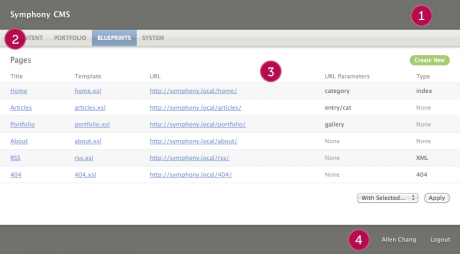Admin Interface
Symphony’s Admin Interface, or back end, enables authors to manage content and system settings.
Overview
The admin interface, often referred to as the “back end,” is a Symphony project’s primary control panel. Once logged in, authors can use the admin interface to set up and configure a project, manage its structure and content, install extensions, and perform other tasks.
Usage
Registered authors can log into the admin interface at http://yoursite.com/symphony.
Details
Symphony’s UI is designed to be clean and functional. A title bar (1) identifies the project. A simple, horizontal menu (2) allows you to navigate through the back end. The main content area (3) is used to display edit forms, entry tables, and the like. Finally, the footer (4) includes links to some basic account utilities.
Functionally speaking, the admin interface provides access to three basic areas:
The first items in a Symphony project’s menu enable management of content entries. The names of these menu items are determined by a project’s visible sections, and by the navigation groups to which those sections belong.
These are followed in the menu by a Blueprints item (Figure 2), where a project’s architecture—namely, its pages, events, data sources, utilities, and sections—can be defined and configured.
Finally, a System menu item (Figure 3) enables administration of authors, system preferences, and extensions.
Note that extensions can add to or alter this default navigation schema. Only authors with a user type of “developer” will have access to the Blueprints and System areas.



